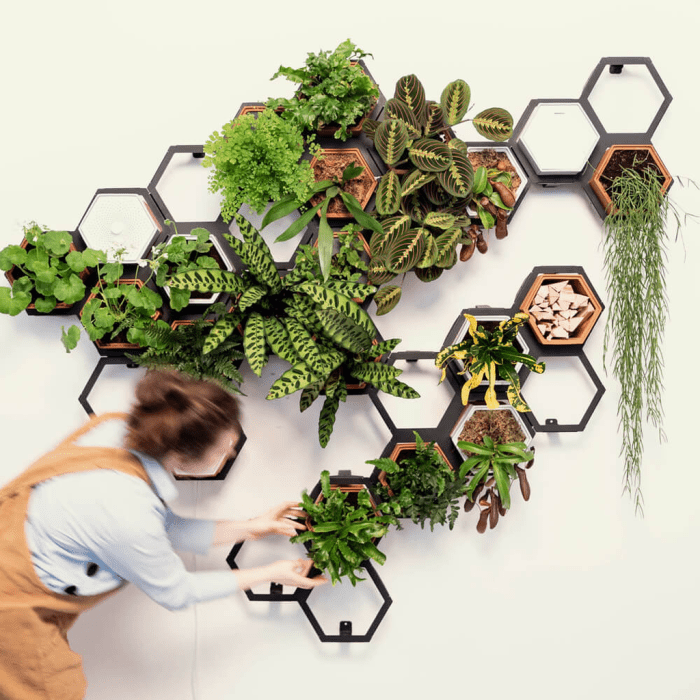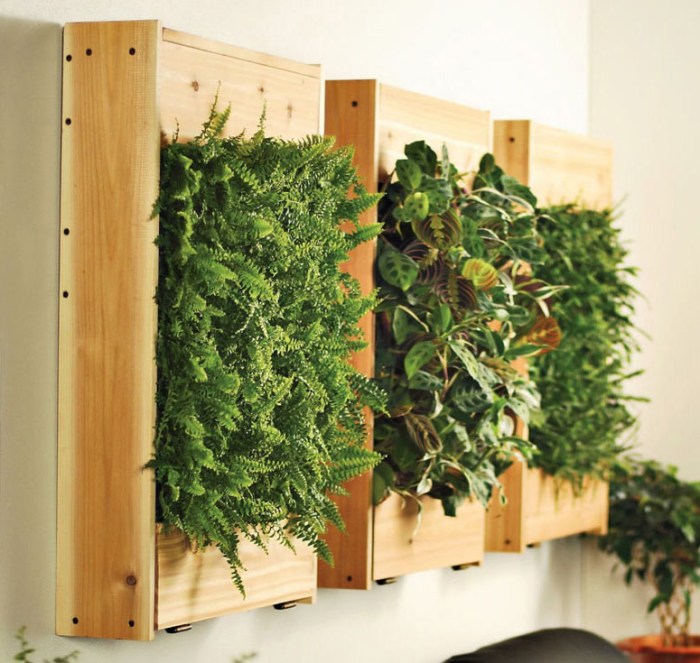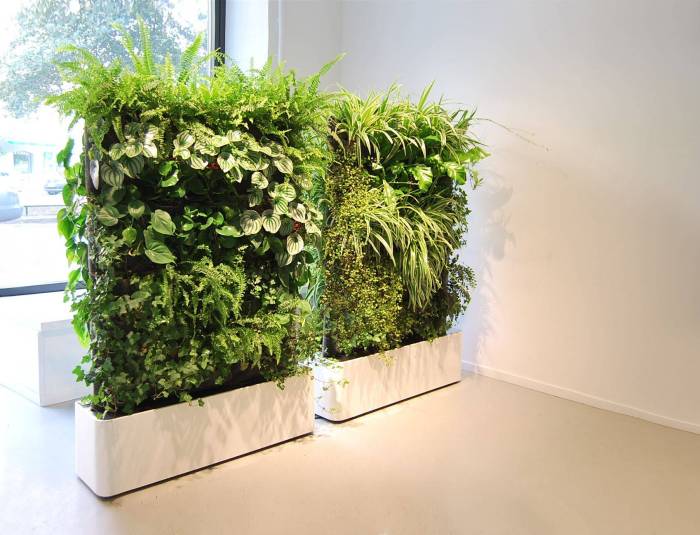Wall planters for indoor plants are a stylish and practical way to add greenery to your home. They’re perfect for small spaces, as they can be mounted on walls or hung from ceilings. Plus, they can help to improve air quality and add a touch of nature to your décor.
There are many different types of wall planters available, so you can find one that fits your style and needs. Some planters are made from ceramic, while others are made from metal or plastic. There are also planters that are designed for specific types of plants, such as succulents or herbs.
Benefits of Wall Planters for Indoor Plants

Vertical gardening is gaining popularity as a space-saving solution for indoor plant enthusiasts. Wall planters offer a unique way to showcase greenery while maximizing floor space.Wall planters add a touch of elegance and visual interest to any room. They can be used to create a living wall, a vertical garden, or simply to display individual plants.
Wall planters are a stylish and practical way to bring greenery indoors. Whether you’re looking to create a living wall or simply add some vertical interest to your space, wall planters offer a versatile solution. From cascading ferns to trailing succulents, there are countless hanging plants indoor that thrive in these vertical gardens.
With their ability to purify the air and enhance the overall ambiance, wall planters are an excellent choice for any indoor space.
By suspending plants vertically, wall planters create a sense of depth and dimension, making small spaces appear larger and more inviting.
Types of Wall Planters for Indoor Plants
Wall planters, with their space-saving design and aesthetic appeal, come in various materials, each offering unique advantages and considerations for indoor plant enthusiasts.
From durable ceramic to lightweight plastic and stylish metal, the choice of material depends on factors such as plant size, weight, and personal preferences.
Ceramic Wall Planters
- Pros:Durable, heat-resistant, glazed surface for easy cleaning, available in various colors and designs.
- Cons:Heavy, can be fragile if dropped, limited drainage options.
- Suitable for:Small to medium-sized plants, succulents, and air plants.
Metal Wall Planters
- Pros:Lightweight, durable, modern and industrial look, good drainage.
- Cons:Can be prone to rust if not treated properly, limited color options.
- Suitable for:Vines, trailing plants, and plants with shallow root systems.
Plastic Wall Planters
- Pros:Lightweight, affordable, versatile, wide range of colors and shapes.
- Cons:Can be less durable than other materials, prone to fading over time.
- Suitable for:Small to medium-sized plants, ferns, and plants that prefer moisture.
Choosing the Right Wall Planters for Your Needs

Selecting the ideal wall planters for your indoor greenery requires careful consideration of size, shape, and design. Factors such as plant size, growth habit, and lighting conditions play a crucial role in ensuring optimal growth and aesthetic appeal.
Size and Shape
The size of your wall planter should correspond to the size of your plant. Smaller plants thrive in compact planters, while larger varieties require more spacious accommodations. Consider the plant’s growth habit as well. Trailing plants look stunning in hanging planters, while upright plants benefit from wall planters with ample height.
Lighting Conditions
The lighting conditions in your space will influence the type of wall planter you choose. Plants that require bright, indirect light may thrive in planters with large openings, while those that prefer low light conditions can be placed in planters with smaller openings or opaque materials.
Matching Décor
To achieve a cohesive look, consider the style and color of your wall planters in relation to your existing décor. Modern interiors pair well with sleek, geometric planters, while rustic spaces complement planters made from natural materials like wood or jute.
Wall planters offer a vertical dimension to indoor plant arrangements, creating lush greenery in limited spaces. Consider pairing them with best hanging plants , which can trail gracefully over the edges, adding a touch of whimsy and elegance to your indoor sanctuary.
Whether you choose succulents, ferns, or trailing vines, wall planters provide a versatile and space-saving solution for enhancing your home’s ambiance with the beauty of nature.
Installing and Maintaining Wall Planters
Properly installing and maintaining wall planters ensures the safety and well-being of your indoor plants. This guide provides a step-by-step approach to installation and discusses essential maintenance practices.
Selecting a Suitable Location
Choose a location that receives adequate sunlight for your chosen plants. Avoid placing planters near heat sources or areas with excessive moisture.
Installing Wall Planters
- Mark the desired location on the wall and use a level to ensure it is straight.
- If the wall is made of drywall, use a stud finder to locate a stud and screw the planter directly into it.
- For concrete or brick walls, use heavy-duty anchors or screws designed for such surfaces.
- Tighten the screws or anchors securely to ensure the planter is firmly attached.
Ensuring Proper Drainage
Adequate drainage is crucial to prevent root rot. If the planter does not have built-in drainage holes, drill small holes in the bottom.
Wall planters are a great way to add greenery to your indoor space without taking up valuable floor space. They come in a variety of shapes and sizes, so you can find one that fits your décor and needs. If you’re looking for a way to add some height to your indoor garden, consider Hanging your wall planters.
This will create a lush, vertical display that will add interest and beauty to your home. Wall planters are a versatile and stylish way to bring the outdoors in.
Watering and Fertilizing
Water wall-mounted plants less frequently than traditional pots due to reduced evaporation. Allow the soil to dry out slightly between waterings.
Fertilize wall planters regularly according to the specific plant’s needs, using a balanced fertilizer diluted to half strength.
Design Ideas for Wall Planters

Wall planters offer a unique way to add greenery and style to any space. They can be used to create living walls or vertical gardens, or simply to display a few favorite plants. Here are a few creative ideas for using wall planters in different spaces:
In the Living Room
- Hang a series of wall planters at different heights to create a living wall that will add a touch of nature to your living space.
- Use wall planters to display trailing plants, such as ivy or pothos, which will add a touch of elegance to your room.
- Create a vertical garden by mounting wall planters on a wall and filling them with a variety of plants.
In the Kitchen, Wall planters for indoor plants
- Hang wall planters near a window to grow herbs that you can use in your cooking.
- Use wall planters to display small succulents or cacti, which will add a touch of greenery to your kitchen without taking up too much space.
- Create a living wall in your kitchen by mounting wall planters on a wall and filling them with a variety of edible plants, such as lettuce, tomatoes, or strawberries.
In the Bathroom
- Hang wall planters near a window to grow ferns or other plants that thrive in humid environments.
- Use wall planters to display small succulents or cacti, which will add a touch of greenery to your bathroom without taking up too much space.
- Create a living wall in your bathroom by mounting wall planters on a wall and filling them with a variety of plants that can tolerate high humidity, such as orchids or bromeliads.
Ultimate Conclusion
Whether you’re looking to add a touch of greenery to your home or create a living wall, wall planters are a great option. They’re easy to install and maintain, and they can help to improve air quality and add a touch of nature to your décor.
Key Questions Answered
What are the benefits of using wall planters?
Wall planters can help to save space, improve air quality, and add a touch of nature to your décor.
What are the different types of wall planters available?
There are many different types of wall planters available, including ceramic, metal, and plastic planters. There are also planters that are designed for specific types of plants, such as succulents or herbs.
How do I choose the right wall planter for my needs?
When choosing a wall planter, you need to consider the size and shape of the planter, as well as the type of plant you want to grow. You also need to make sure that the planter has proper drainage.